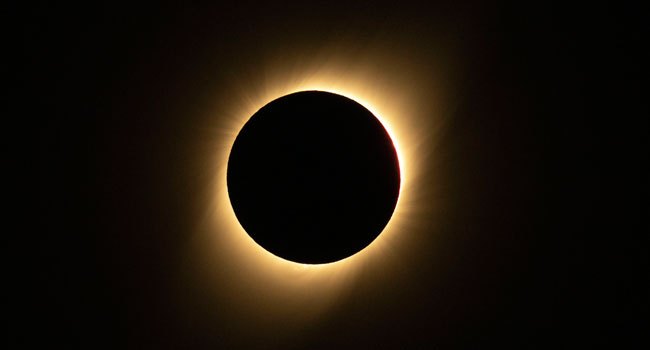
Things To Know About Monday’s Total Solar Eclipse
Scientists will be able to collect priceless information on a variety of topics, including the Sun's atmosphere, unusual animal behaviours, and potential effects on people, when a rare complete solar eclipse crosses North America on Monday.
When it occurs, the Sun is almost at the pinnacle of its 11-year solar cycle, which creates the ideal conditions for an amazing show. The corona will light brilliantly from the Moon's silhouette throughout the path of totality, which runs through the United States and Mexico.
NASA Deputy Administrator Pam Melroy described total solar eclipses as "incredible scientific opportunities" during a press briefing this week.
Solar prominences—massive plasma formations that loop out from the surface of the Sun—and solar flares—sudden explosions of energy that discharge radiation into space—occur in the corona.
According to Shannon Schmoll, director of Michigan State University's Abrams Planetarium, "during an eclipse, the bottommost part of the corona—where a lot of this activity occurs—is more clearly visible than when using specialised instruments to block the central part of the Sun, offering a golden opportunity for study."
The fact that the Sun is getting close to the end of its 11-year cycle excites scientists in particular.
"There's a very high probability that we will witness something truly amazing," Melroy stated.
The ionosphere, a region of the Earth's upper atmosphere that is significant because it influences radio waves used for communication and navigation, will be the subject of scientific investigation during the complete eclipse.
Kelly Korreck, the eclipse programme manager at NASA headquarters, stated that "disturbances in this layer can cause issues with GPS and communications."
During the day, the Sun electrically charges the particles in the ionosphere, the region where Earth's atmosphere meets space.
NASA intends to measure these changes by launching its three sounding rockets from Virginia prior to, during, and immediately following the eclipse.
Because the eclipse caused a significant drop in sunlight, which was more quick and localised than a typical sunset, scientists should be able to learn more about how light impacts the ionosphere and make more accurate predictions about potential disruptive events.
Animal behaviour - During eclipses, startling animal behaviour has been observed: giraffes have been observed running, while crickets and roosters have been known to begin chirping and crowing.
Aside from the reduction in sunshine, an eclipse can also cause a considerable drop in wind and temperature, two other factors that affect animals.
Ornithologist Andrew Farnsworth of Cornell University in New York state uses weather monitoring radar to find birds in flight as part of his research on the effects of eclipses on birds.
According to Farnsworth, scientists saw a "decline in the number of animals flying around" during the most recent total solar eclipse that was visible from the United States in August 2017.
According to the expert, the 2017 eclipse disturbed insects' and birds' regular routines but did not cause any of the customary nighttime animal behaviours, such bats emerging or birds migrating.
Given that the eclipse is occurring in April this time, he said that birds may be more likely to move during it.
Farnsworth stated, "These kinds of patterns—they're important for understanding the ways animals perceive their worlds."
Wonder of humans
"There is a unique power in eclipses. NASA Administrator Bill Nelson told reporters, "They inspire people to feel a kind of reverence for the beauty of our universe."
In 2017, researchers used data from around three million Twitter users—now known as X—to study this sense of awe.
Paul Piff, a psychology professor at the University of California, Irvine, has observed that people in the so-called "path of totality," in which the Moon will completely obstruct the Sun, have a tendency to refer to others by the pronoun "we" rather than "I" and to demonstrate care for others.
According to Piff, "we're finding that awe-inspiring experiences... seem to attune people and connect us to one another, to connect us to entities that are larger than ourselves."
He wants to find out this year whether the experience affects societal political divides in any way.
- Citizen scientists: About forty citizen scientific initiatives are scheduled in relation to the eclipse. These initiatives range from collecting background noise during the event to utilising a phone app to track temperature and cloud cover.
Nelson stated, "We encourage you to assist NASA in observing the sights and sounds around you."





